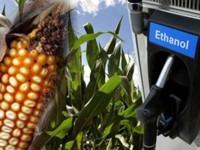Non-food crops lock up enough calories to feed 4 billion
 Global calorie availability could be increased by as much as 70 per cent - feeding an additional 4 billion people - by shifting cropland use to produce food for humans rather than livestock feed and biofuels, according to new research.
Global calorie availability could be increased by as much as 70 per cent - feeding an additional 4 billion people - by shifting cropland use to produce food for humans rather than livestock feed and biofuels, according to new research.Such a shift could free up calories roughly equivalent to the yield increases achieved for maize, wheat and rice between 1965 and 2009, researchers say in the study, published in Environmental Research Letters this month.
“When talking about the future of food security, people often suggest that we grow our way out of the problem: that if we just keep producing more corn and soybeans we will be able to feed the world. Our study provides an alternative point of view,” Emily Cassidy, lead author of the study and environmental scientist at the University of Minnesota, United States, tells SciDev.Net.
Researchers looked at the 41 crops that provide more than 90 per cent of world’s calories. They analysed where the crops are grown, the overall production and also how the crops are used: for direct human consumption, animal feed or biofuels.
“Globally, 36 per cent of all calories are fed to animals. We found that decreasing grain-fed meat consumption by 50 per cent would be enough additional calories for two more billion people,” says Cassidy.
Reducing meat consumption, or shifting it away from beef to poultry and pork, has the potential to feed more people per hectare of cropland because beef is not energy efficient, Cassidy adds.
“When we feed 100 calories of average corn and soy to beef cattle we get only three per cent of these calories back, while the efficiency is better for pork and chickens,” she says.
Researchers also looked at crop allocation in terms of proteins.
“Half of the protein that we produce with crops actually goes to animals for feed. We could have the right amount of protein and amino acids if we were to directly consume crops,” says Cassidy. “We are actually losing a lot of protein in the plant-animal conversion process.”
Yet, the authors recognise that the recent global trends are towards more meat consumption and biofuel production.
“Meat is part of the human culture and it’s important for food security in many parts of the world, but when we increase crop yields in affluent nations we are just feeding animals and this is not turning into much food for human consumption,” says Cassidy.
According to Cassidy, a shift from yield intensification for meat production in rich countries could redirect investments and attention to countries in Africa and South Asia that need to increase crop productivity to feed people.
But Barbara Adolph, a researcher at the International Institute for Environment and Development, in United Kingdom, believes that the problem is not just related to present agricultural resources and investments.
“One of the challenges is that most of the meat consumption will soon be happening in China and to a lesser extent India, as well as Sub-Saharan Africa, where the growing middle class is consuming more and more meat and dairy products,” she tells SciDev.Net. “So re-allocation of crop land in the rich countries will only go so far - we also need to think about changing consumption patterns among the rich in the South.”
Barbara Burlingame, a deputy director at the nutrition and consumer protection division of the UN’s Food and Agriculture Organization, says: “We cannot be dogmatic about meat and dairy consumption, because a little goes a long way in terms of quality nutrients for the diet”.
She adds that “bringing food losses and waste under control, fromagriculture through household and retail, will serve to relieve pressures on natural resources”.
However, she tells SciDev.Net: “If agriculture were nutrition-driven, we would see global demand for meat and dairy decrease, and we would see less land use for biofuels “.
You can return to the main Market News page, or press the Back button on your browser.

